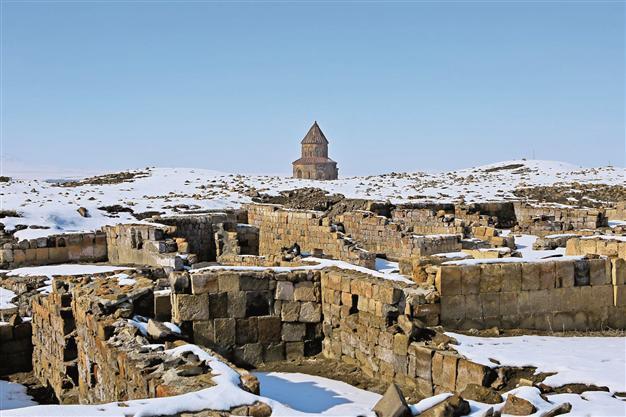Work ongoing to put Ani on UNESCO heritage list
KARS - Anadolu Agency

AA Photo
Work is continuing at the ancient ruins of Ani, a 5,000-year-old Armenian city located on the Turkish-Armenian border in the eastern province of Kars, with an eye on including the site on UNESCO’s World Heritage List.
Work has been continuing at Ani, which has been home to many civilizations throughout history and is today a major draw for tourists in the area, with the support of Turkey’s Culture and Tourism Ministry.
Ani is located 40 kilometers from the city of Kars, where tourists usually base themselves during trips to visit the remote site.
Local Culture and Tourism Director Hakan Doğanay said salvage excavations in Ani would be headed this year by Pamukkale University Classical Archaeology Department Professor Fahriye Bayram.
Doğanay said projects regarding the restoration of the ancient city’s walls have now been finished, with an eye to including Ani on the UNESCO’s heritage list.
“[Ani] may enter the UNESCO list during the meeting to be held in Oslo in 2016. We predict that 2015-2016 will be the years of Kars and the ancient ruins of Ani. The Culture and Tourism Ministry has provided us with great support on this issue,” he said.
“We will also bring over 21 new artifacts from various cultures, making the best use of cultural heritage in our region,” Doğanay added. “Ani is a treasure for us that should be included in the UNESCO World Heritage List.”
Ani, which occupies 78 hectares of land and is surrounded by 4,500-meter-long ramparts, was once the capital of a medieval Armenian kingdom that covered much of present-day Armenia and eastern Turkey.
Ani is protected on its eastern side by a ravine formed by the Akhurian River and on its western side by the Bostanlar or Tzaghkotzadzor Balley. The Akhurian is a branch of the Aras River and forms part of the current border between Turkey and Armenia.
Dubbed the “City of 1,001 Churches,” Ani stood on various trade routes, and its many religious buildings, palaces, and fortifications were among the most technically and artistically advanced structures in the world at the time, according to specialists.
